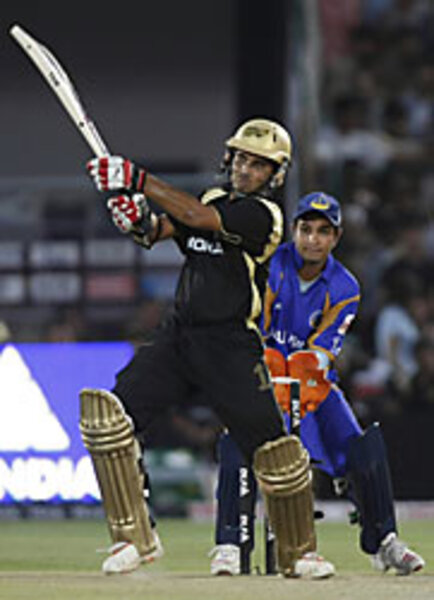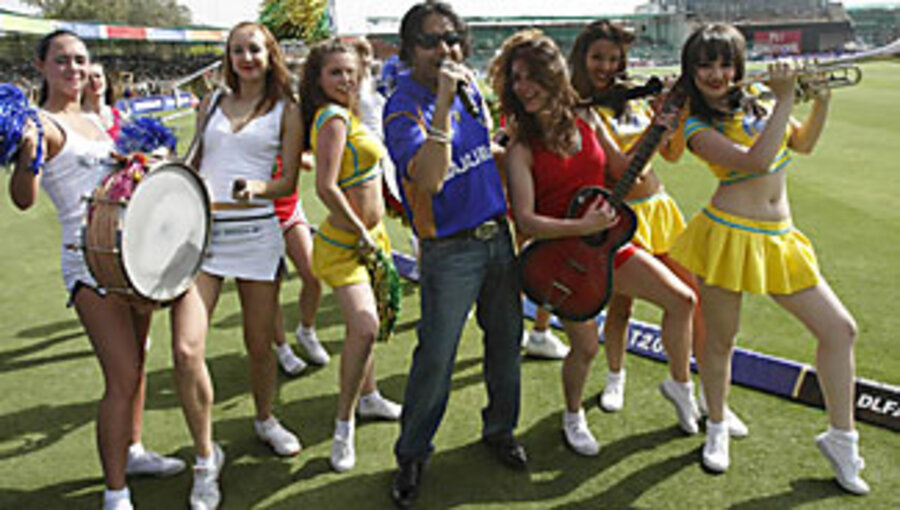Cricket's Indian revolution: fast play and more pay
Loading...
| Hampshire, England
To the uninitiated, it is a baffling sport. Matches can last five days – and still end in a draw. There are rules for when you can have tea, and long periods seem to elapse when nothing much is happening.
But suddenly cricket, a game of attrition exported by the British to the rest of the Empire, is undergoing a startling revolution. And the catalyst isn't from the land of the game's birthplace, but from an American billionaire and – gasp – a former colony, India.
The game has been condensed from days into a three-hour prime-time ready TV slot that defies almost every tradition of the sport. White uniforms are out. Lasers, scantily clad cheerleaders from Washington, D.C., and rock music are in.
There is now more action, more big hitting (for once a British sport has more scoring than its US counterpart). Think of it as a soap opera compared with a five-act Shakespeare play; one is full of melodrama and adrenaline, the other is absorbing, complex, sometimes hard work but ultimately richly rewarding.
This incarnation of cricket is called Twenty20 – referring to a limit of 20 "overs" which are akin to "innings" in baseball. The format was actually initiated in England five years ago. And it's been a success in pulling in the after-work crowd and giving a complex, arcane sport a universal appeal.
But in the past month, India has taken the concept to a new level of popularity and prosperity. The Indian Premier League (IPL) is making the rest of the sporting world stand up and take notice.
"Twenty20 is changing everything. The game we are used to seeing played over four or five days is moving into the background," says Matthew Thacker, publisher of All Out Cricket magazine.
The new Indian league is playing to packed stadiums and soaring TV ratings, pulling in more fans than in the rest of the cricket world combined and, most critically, a cool billion dollars in television and other media rights have set the standard.
So rapid is the game's growth that US billionaire Sir Allen Stanford is ready to pour in as much as $1 billion of his own money to set up a rival to the IPL. Stanford told the BBC that "Twenty20 ... has the potential to be the most popular team sport in the world."
But amid the heady ambitions to vault cricket above its more glamorous sports cousins lurk persistent concerns: that Twenty20 will come to define the game, eclipsing the more subtle arts of the longer version; and that India's purchasing power will suck in the best players from all around the world, leaving other countries with second-best fare.
"You have a new form of the game which is proving wildly popular combined with this huge change in the power and politics of cricket because of the growth of India as a market," says Matthew Engel, editor of the sport's authoritative reference book, Wisden Cricketers' Almanack.
But it's not merely the truncation or the bling that has the traditionalists worried. Twenty20 is fundamentally altering the economics of the game.
The IPL paid its top players more for six weeks' work (up to $1.5 million) than some players make in a career. This has caused deep anxiety in England and elsewhere. Several players have already walked out on their national teams to seek a fortune on the subcontinent and have been banned.
One who did so, New Zealand's Shane Bond, said in a recent interview that the ban was "unfair" but would not change his decision. "I'd have to play for years for New Zealand to earn the same amount of money – and play in every game," he told the Guardian. "So the decision to go to India is a no-brainer."
"If you work for a bank and an American bank offers you four times the salary for a quarter of the work why wouldn't you want to do it?" asks Mr. Thacker.
To persuade players not to head to India, the English authorities are now scrambling to provide alternative lucrative tournaments closer to home.
Mr. Stanford has said that has said he is ready to bankroll international Twenty20 games involving England in which the winning side will take home $20 million.
But that will only be for the elite players. For the rest, a revamped domestic competition is in the cards, though it seems certain that this will not come close to rivaling the IPL. English cricket chief Giles Clarke hinted at a conservative approach last week when he said: "Tradition and history rather than Bollywood stars and glitz are the binding which persuade supporters to return week in, week out to our grounds."
For many players, the temptation to take up Indian offers may prove too alluring. A survey by the professional body, the Players Cricket Association, found that almost a fifth of English players are prepared to face a ban at home for the chance to make big money in India.
England fast bowler Sajid Mahmood told the BBC this week: "A lot of people on the circuit are saying the IPL is the way forward. My aim is and always has been to play for England, but if you're not getting in the side, the IPL is a big carrot."
Paul Allott, a former England international, says there is a distinct possibility that some players might prefer the financial inducement of Twenty20 cricket to the less lucrative traditional game. But he doesn't see the five-day international game being totally eclipsed any time soon. "The current crop of top players are still more interested in seeing how well they can do in the long form of the game," Mr. Allott says.
Cricket last went through similar convulsions 30 years ago when the Australian media tycoon Kerry Packer set up a break-away tournament that introduced shorter games (though not as short as Twenty20) and enticed the very best in the game. On that occasion, the experiment ended in rapprochement. But most of its innovations – colored clothing, floodlit evening matches, white balls, punishing schedules, lucrative merchandising – have remained.
In a way, the Twenty20 revolution is merely completing what Mr. Packer started.






